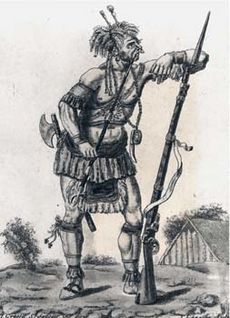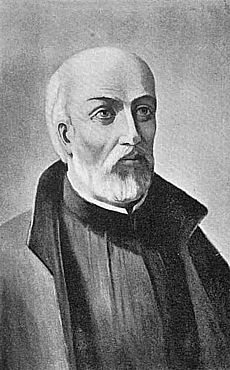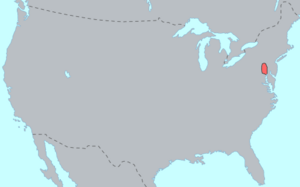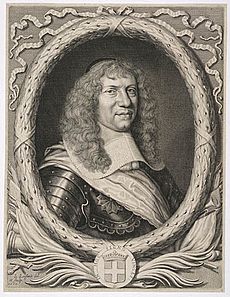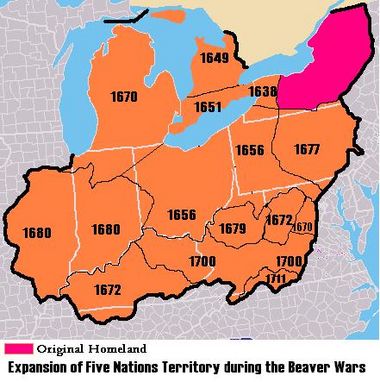Beaver Wars facts for kids
Quick facts for kids Beaver Wars |
|||||||
|---|---|---|---|---|---|---|---|
| Part of the American Indian Wars | |||||||
|
|||||||
| Belligerents | |||||||
|
Supported by: |
|||||||
| Strength | |||||||
| ~4,500 | ~20,000 | ||||||
| Casualties and losses | |||||||
| Unknown | Unknown | ||||||
The Beaver Wars, also known as the Iroquois Wars or the French and Iroquois Wars, were a series of conflicts in the 1600s. These wars took place in the Great Lakes region of North America. The main conflict was between the Iroquois Confederacy and the Wendat (also called Huron), northern Algonquian tribes, and their French allies.
The Iroquois wanted to control the fur trade with Europeans and expand their lands. The Iroquois Confederacy was a powerful group made up of five tribes: the Mohawk, Oneida, Onondaga, Cayuga, and Seneca. They received weapons from their Dutch and English trading partners. Their opponents, including the Wendat and Algonquin tribes, were supported by the French.
During the wars, the Iroquois were very successful. They defeated and scattered several other Native American groups, including the Wendat, Erie, and Susquehannock. This changed the map of the region, as the Iroquois controlled a large territory. The wars also had a big impact on the beaver population, which was hunted so much that it nearly disappeared from the area. The conflict finally ended in 1701 with a peace treaty called the Great Peace of Montreal.
Contents
Background of the Conflict
When French explorers like Jacques Cartier arrived in the 1540s, they began trading with Native American tribes for valuable furs. By the early 1600s, France had established a colony called New France and built the town of Quebec. The French became allies with the Wendat and Algonquin tribes, trading goods with them in exchange for furs.
The French leader, Samuel de Champlain, decided to help his allies in their wars against the Iroquois. In 1609, Champlain and his soldiers joined a Wendat and Algonquin war party. Using French guns called arquebuses, they defeated a group of Mohawk warriors. This was the beginning of a long conflict between the French and the Iroquois.
Competition for the Fur Trade
The fur trade was very important to both the Europeans and the Native Americans. Beaver pelts were especially popular in Europe for making hats. The Iroquois wanted to be the main group trading furs with the Europeans.
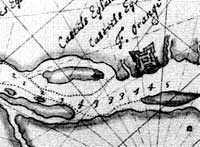
In the 1610s, Dutch traders arrived and set up posts like Fort Orange. This allowed the Iroquois to trade directly with the Dutch, who supplied them with guns and other metal tools. Having firearms gave the Iroquois a major advantage over their enemies, many of whom could not get guns from their French allies.
By the 1640s, beavers had become rare in the Iroquois homeland in what is now New York. To find new hunting grounds and control the fur trade, the Iroquois began to expand their territory by attacking their neighbors.
The Wars Unfold
The Beaver Wars became more intense in the 1640s. The Iroquois, now well-armed with Dutch guns, launched major attacks on other tribes to take control of their lands and fur supplies.
The Fall of the Wendat Confederacy
The Wendat were one of the most powerful groups allied with the French. They lived in the area north of the Great Lakes and controlled a large part of the fur trade. In 1648, the Iroquois launched a massive attack on the Wendat villages.
Within a few years, the Wendat Confederacy was destroyed. Many Wendat were killed in the fighting, while others were captured and became part of the Iroquois tribes. The survivors fled, with some moving west and others seeking protection near the French settlements. Among those killed were several French Jesuit missionaries, including Jean Brebeuf.
Iroquois Expansion
After defeating the Wendat, the Iroquois continued their conquests. In 1650, they attacked the Neutral tribe, who lived west of the Iroquois. By 1651, the Neutrals were also defeated and scattered.
Next, the Iroquois attacked the Erie tribe, who lived south of Lake Erie. After a two-year war, the Erie confederacy was destroyed by 1656. With these victories, the Iroquois controlled a vast territory rich in furs, stretching from the St. Lawrence River to the Ohio Valley.
The French Fight Back
For years, Iroquois war parties raided deep into New France, even attacking the outskirts of Montreal and Quebec. The French colony was in danger of being completely cut off from its allies and the fur trade.
In the mid-1660s, the situation changed. The King of France sent a regiment of about 1,000 professional soldiers, the Carignan-Salières Regiment, to defend the colony. In 1666, the French governor led these troops on an invasion of the Mohawk homeland. They burned Mohawk villages and destroyed their food supplies.
This show of force convinced the Iroquois to make peace. In 1667, a treaty was signed that brought a period of calm for about ten years.
A Shift in Power
During the peace, the Iroquois focused on expanding their territory to the west. They attacked tribes in the Ohio and Illinois Country, forcing groups like the Shawnee and Miami to move.
However, the peace with France did not last. In the 1680s, the French began building forts and trading posts in the west, which the Iroquois saw as a threat to their control of the fur trade. The fighting started again. This time, the French armed their own Native American allies with guns, making the conflict more even.
The English had also taken over the Dutch colonies, including Fort Orange (renamed Albany). The English became the new trading partners and allies of the Iroquois, supporting them against the French. The Beaver Wars became part of a larger struggle between England and France for control of North America.
The Great Peace of Montreal
By the late 1690s, after decades of fighting, all sides were growing tired of the war. The Iroquois were also facing a new threat from the growing English colonies to the south.
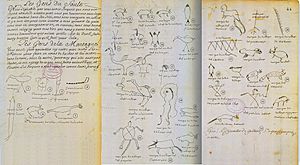
In 1701, the French invited leaders from the Iroquois and more than 30 other Native American nations to a grand council in Montreal. After weeks of negotiations, they all signed a treaty known as the Great Peace of Montreal.
In the treaty, the Iroquois agreed to stop their attacks and remain neutral in any future wars between the English and the French. This peace agreement was a major achievement and brought stability to the Great Lakes region for many years.
Lasting Impact
The Beaver Wars had a huge effect on the history of North America.
- Changes for Native American Tribes: The wars completely changed the lives of many tribes. Some, like the Wendat, were nearly destroyed. Others were forced to leave their ancestral lands and move hundreds of miles away. The Iroquois became the dominant Native American power in the northeast for a time.
- The Beaver Population: The intense hunt for furs during this period devastated the beaver population. In many areas, beavers were completely wiped out. This had a lasting impact on the environment, as beaver dams are important for creating wetlands that support other wildlife.
- European Colonies: The conflict shaped the relationship between the French, English, and Native American nations. The alliances formed during the Beaver Wars would continue to play a role in later conflicts, such as the French and Indian War.
Images for kids
-
A drawing of the Battle of Long Sault in 1660, where a small group of French soldiers and their allies fought against a much larger Iroquois force.
-
Louis de Buade de Frontenac, a famous governor of New France, meeting with his Native American allies.
See also
 In Spanish: Guerras de los Castores para niños
In Spanish: Guerras de los Castores para niños
- American Indian Wars
- Colonial American military history
- Fox Wars
- Military history of Canada
- Military history of the Mi'kmaq people
- Military of New France


